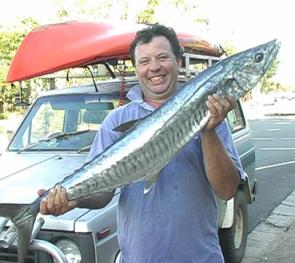April is a fantastic fishing month, consistently delivering excellent beach and close inshore pelagic action. More tailor frequent the gutters along Teewah Beach during April than at any other time of year because bait schools are herded onto the shoreline by mackerel and tuna and conditions generally settle down after seasonal low pressure systems in February and March.
Often queenfish, yellowtail kingfish, tarpon, cobia and a few varieties of trevally can be found around the bait as well. More conventional surf species such as bream, whiting, dart, flathead, tarwhine and the occasional oyster cracker are also present.
Noosa has received consistent rainfall through February and into March, but nothing sufficient so far to trigger inshore fish activity. However, whether it is this system or the next, an imminent deluge is likely to create the conditions that make April the month to be here.
For me, spotty, broad barred and Spanish mackerel, longtail tuna, tailor, queenfish and trevally are my main targets during April. There is permanently a rod loaded with a 45g Slider in my holder, ready for any reachable schools that I may see while driving along the beach.
Rainbow Beach becomes prime territory with longtail schools constantly cruising between Middle Rocks and Double Island, feeding on frogmouth pilchards along with a mix of the other species. The stretch of beach between The Leisha Track and the first high coloured sand hills is good for targeting these pelagics as access to the main channel is not difficult. Sight fishing for feeding schools is easy in this sheltered area and it is not unusual for the schools to be well within casting range.
Retrieving metal lures at high speed is really the only way to hook up to any of these speedsters during the day and this can be a spectacular and rewarding method of fishing. To land one longtail or queenfish of any decent size off the beach is a thrilling experience and watching them swim away after release also takes some beating.
Commercial netting of the Noosa River and lakes, along with beach seine netting, seem to be the most likely reason that fish stocks in this region have radically reduced over the last 30 years. Behavioural changes of migrating fish such as tailor and mullet compounds this problem, as does the netting of the fragile ecosystems of the Noosa River system for prawns and mullet.
Despite the frighteningly low fish stocks, the Department of Primary Industries and Fisheries have absolutely no plan to change any of the potential causes. It’s difficult to understand why they are not taking action, as the instances of fish returning to areas where netting has been reduced or banned are numerous and well documented. The return of yellowtail kingfish schools into Sydney Harbour is just one example and has occurred despite the size of the human population on its shores.
Many countries around the world have experienced exactly the same circumstances of fish stock reductions. Some have altered their netting practices prior to stocks crashing entirely and still have a fishery, whereas others didn’t react in time and no longer have a fishing industry of any worth to anybody.
This brings into play an issue that is controversial in Queensland and has the fishing fraternity somewhat divided in their views. Saltwater fishing permits for recreational anglers have been something that the Queensland Government has resisted. However, with no funds being allocated from the state coffers by any ruling party to buy back licenses in a strategic fashion to allow our inshore fishery to recover, shouldn’t we as anglers be demanding a permit system to ensure such a buy back?
New South Wales, Victoria and South Australia have permit systems and they have produced staggering results. The fish are coming back into areas that have been addressed and I am yet to hear a complaint about the system from anglers in these states. Most people think that being able to catch and eat fish again is well worth the relatively low cost of a permit.
I don’t really care where the funds for a buy back scheme come from. I just know that if we sit on our hands for many more mullet seasons, things can only get worse. February and early March this year have not been very good from an angling point of view. The river has been particularly quiet and the surf and close inshore fishery has been very patchy to say the least.
These months are generally very healthy for tailor migrating south along the coast, but this year with quality weed-free gutters to work with, there has been only very isolated catches. I am concerned that the tailor may now be largely bypassing Teewah Beach altogether on both their northern and southern migration.
Reads: 1180

Paul Anderson with a 7.5kg Spanish mackerel that was caught out from Mooloolaba while fishing from a kayak.




